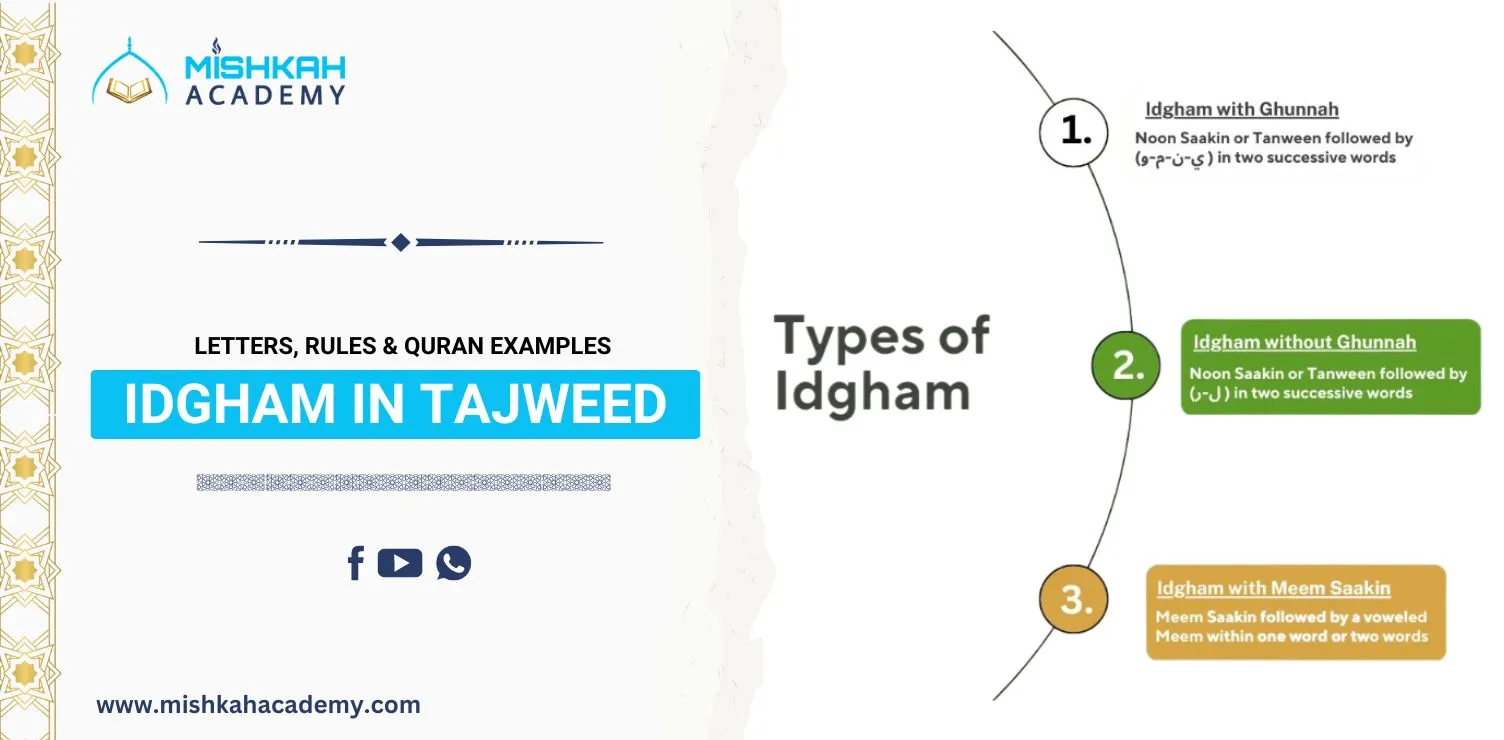Tajweed is a method of correctly reciting the Quran, paying attention to the specific pronunciation of each letter. Idgham is one of the many Tajweed rules, and it has a big impact on how words are understood and recited in the Quran. To give readers a solid understanding of this important Tajweed law, we shall examine the definition of Idgham, its guidelines, its letters, and instances from the Quran in this essay.
What is Idgham in Tajweed?
Table of Contents
ToggleThe literal meaning of the term Idgham is “to merge” or “to combine.” Idgham, as used in Tajweed, is the rule that one letter is blended into another to facilitate an easy pronunciation transition. This method helps to make Quranic recitation more beautiful and improves the flow of the recitation.
The Letters of Idgham
The six letters involved in Idgham are essential to remember as they dictate when and how the merging occurs. These letters are remembered using the mnemonic “يَرْمَلُونَ” (yarmaloon), which helps in recalling the Idgham letters:
ي (yaa)
ر (raa)
م (meem)
ل (laam)
و (waw)
ن (noon
Idgham only appears in specific letters. Six letters are connected to Idgham, and they fall into two categories:
1: Idgham with Ghunnah Letters (Nasal Sound):
ن (Noon)
م (Meem)
The first letter’s nasal quality blends into the second when these letters come before the next letters. For instance, a nasal sound is made when the letter ن (Noon) is uttered after the letters ي, و, or ن,
2. Idgham without Ghunnah Letetrs
ل (Laam)
ر (Raa)
ج (Jeem)
ش (Sheen)
ص (Saad)
ض (Daad)
In this case, the first letter is completely absorbed into the second letter, eliminating any nasal quality in the transition.
Note: Enroll in Advance tajweed course with native arab tutors to learn quran reading rules with tajweed properly.
Idgham’s Rules
Understanding the regulations of Idgham is necessary for the correct recitation of the Quran. The following are the primary guidelines:
1. Conditions for Idgham
When a letter from the Idgham letters comes after the initial letter (ن or م) Idgham applies. Idgham does not occur if the first letter does not satisfy this requirement.
2. Ghunnah with Idgham (Idgham Ma’a Ghunnah)
The letter ن (Noon) needs to be spoken with a nasal sound when it comes after ي, و, or ن, For instance, in the sentence “أَن يَكُونَ” (an yakuna), the ي and ن blend together beautifully.
3. Idgham without Ghunnah(Idgham Bila Ghunnah)
The sound is combined but loses its nasal quality when the letter ن is followed by the letters ل (Laam) or ر (Raa), For instance, the ن is absorbed into the ب in the word “أُنْبِئُكَ” (unbi’uka).
Exceptions:
Even if the letter that came before it was an Idgham letter, there are situations in the Quran where Idgham may not apply. This is required by the context and particular laws of the Quran, which is why thorough study and practice are required
Idgham only comes into play when one of the six Idgham letters comes after a noon sakinah or tanween. ي (yaa), ن (noon), م (meem), ر (raa), ل (laam), and و (waw).
If a noon sakinah or tanween is followed by any letter other than the six Idgham letters, or by the hamzah (ء), then no Idgham takes place.
Idgham with Ghunnah (nasal sound) and Idgham without Ghunnah are two additional categories for the Idgham process:
Idgham with Ghunnah: Idgham is recited with a nasal sound when it contains the letters ي (yaa), ن (noon), م (meem), or و (waw),
Idgham without Ghunnah: The letters blend together without any nasalization when the noon sakinah or tanween is followed by ر (raa) or ΄ (laam)ل .
When the noon sakinah or tanween ends one word and the Idgham letter starts next word, Idgham cannot occur in between two words. Actually, it happens when they are next to each other within a word or between two words when there isn’t a stop between them.
Idgham Rules in English
According to Idgham regulations, you must merge Nun As-Sakinah or Tanween into the letter if it follows one of the Idghaam letters. Because Shaddah is present.
In Idgham pronunciation, the sakinah and tanwin are swallowed up or consumed by the letter that comes after them. When the idgham letters come before the sakinah and tanwin, they are pronounced with a “merge” sound.
Examples of Idgham in the Quran
Here are some examples of idgham taken from Holy Quran.
Idgham with Ghunnah Example
Surah Al-Baqarah (2:228):
Verse: “وَإِذَا طَلَّقْتُمُ النِّسَاءَ فَبَلَغْنَ أَجَلَهُنَّ فَلَا تَعْضُلُوهُنَّ”
Idgham: The ن (noon) in “فَبَلَغْنَ” merges into the ن in “أَجَلَهُنَّ” with a nasal sound.
Surah Al-Anfal (8:61):
Verse: “وَإِن جَنَحُوا لِلسَّلْمِ فَاجْنَحْ لَهَا“
Idgham: The ن (noon) in “وَإِن” merges with the ج (jeem) in “جَنَحُوا” producing a nasal sound.
Idgham without Ghunnah Example
Surah Al-Baqarah (2:191):
Verse: “وَأَنْتُمْ الأَعْلَوْنَ”
Idgham: The ن (noon) in “أَنْتُمْ” merges with the ت (taa) in “الأَعْلَوْنَ” without a nasal sound.
Surah Al-Muddaththir (74:11):
Verse: “أُنْبِئُكَ”
Idgham: The ن (noon) merges into the ب (baa) without ghunnah.
Surah Al-Haaqqa (69:18):
Verse: “فَأَنتَ إِلَىٰ رَبِّكَ يَوْمَئِذٍ الْمَسَاقُ”
Idgham: The ن (noon) in “فَأَنتَ” merges into the ر (raa) in “إِلَىٰ” without a nasal sound.
The Importance of Idgham in Tajweed
It’s important to understand and apply Idgham correctly for a number of reasons.
Improves Recitation Flow: Idgham smoothes out quick stops in the recitation, leaving it more mellow and flowing.
Preserves Quranic Tradition: The holy tradition of reciting the Quran is preserved when Idgham is used correctly, which guarantees that the Quran is recited exactly as it was revealed to Prophet Muhammad (PBUH).
Makes Understanding of the Quran: Idgham has an impact on both pronunciation and meaning. Understanding Idgham’s guidelines will guarantee that the right meaning is given, as improper use of the tool could result in misunderstanding of the text. So every muslim must learn tajweed properly by enrolling in online tajweed course with native arab tutors to better learning.
Importance of Idgham in Quranic Recitation
Idgham has multiple functions when reciting the Quran:
Improving Fluency: Idgham makes the quran recitation easier to listen to by keeping it fluid and easy to follow.
Clarity of Meaning: When Idgham is used correctly, it guarantees that words are understood exactly as intended, avoiding misunderstandings.
Maintenance of Tradition: The traditional way of reciting the Quran is ensured to be carried down through the generations by following Tajweed rules such as Idgham.
Conclusion
Idgham, which expresses the beauty and depth of the Quranic language, is a vital part of Tajweed. Idgham supports seamless transitions between sounds using letters, which improves the aural experience of Quranic recitation. Anyone who wants to correctly recite the Quran must learn these rules, whether it be for Idgham with Ghunnah, which adds a nasal sound, or Idgham without Ghunnah, which does not.
Reciters help to maintain the true meaning of Quranic recitation by mastering and using Idgham, ensuring that it stays as pure and elegant as it was revealed. The principles of Idgham are essential to mastering Tajweed recitation and developing a closer relationship with the Quran, regardless of experience level.






